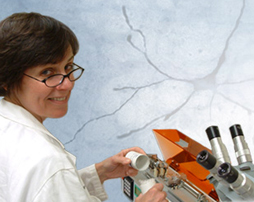Research

As the state's only health and research university, OHSU brings together education, research, patient care and community service. While each component has its own individual goals and mission, all of them are bound together by a common vision - to improve the well-being of Oregonians.
New discoveries and treatments at OHSU are creating hope for millions of people who cope with neurological problems that affect how they interact with the world. Detailed in this research section of the web site you will find how unique basic and clinical research at OHSU is contributing to enhance, improve and advance neurosurgical outcomes for patients.
Research in the Department of Neurological Surgery is headed by Mary M. Heinricher, Ph.D., whose work on how the brain controls pain is internationally recognized. Investigators in the department study brain disorders in the laboratory and at the bedside.
Summary of basic research studies (by investigator)
- Mary M. Heinricher, Ph.D., Professor: brainstem mechanisms involved in pain modulation. The focus is on opioid-sensitive circuits within the rostral ventral medulla, which is a crucial element in a pain-modulating network with links in the midbrain, medulla and spinal cord.
- Ahmed Raslan, M.D., Professor: laboratory has a threefold vision; 1) basic science discovery, 2) clinical research development, and 3) application of translational medicine. The lab focus is; Discovery as it relates to the fundamental nature of human cognition, with an emphasis on numerical cognition and emotion. Clinical data collection and analysis to inform and improve neurosurgical practice at all levels; specifically treatment of medically refractory epilepsy and pain.
-
Domenico Tupone, Ph.D. Research Assistant Professor: understanding (a) the intersection of CNS circuits regulating body temperature and sleep-wake state, (b) the CNS mechanisms responsible for alterations in thermoregulation and sleep-wake state during hibernation and torpor-like states, and (c) the application of this framework to the induction of therapeutic hypothermia, particularly related to improving outcomes in models of ischemic injury.
Summary of clinical research studies (by condition)
- Pain: surgical treatments for trigeminal neuralgia.
- Epilepsy
- Oregon’s first brain surgery with a robotic assist
- OHSU joins $12.8 million NIH grant to improve epilepsy treatment
- Human brain mapping with groundbreaking resolution; new sensor grids could transform precision of neurosurgery, expand understanding of the brain
- Movement disorders: clinical studies of deep brain stimulation (DBS) for tremor associated with Parkinson's disease and other movement disorders, e.g asleep vs. awake DBS
- Brain tumors: improved surgical treatments for adult and pediatric brain tumors.
- Clinical studies of therapies for Cushing's disease; growth hormone and testosterone therapy for panhypopituitary tumors.
- Chiari malformation: development of pediatric guidelines.
- Interventional neuroradiology as a minimally invasive approach in the treatment of diseases of the brain and spine.
- Spine: patient outcomes. Spinal cord injury treatments.